Hippopotamus
Hippopotamus amphibius
Has pink anti-bacterial sweat!
Advertisement
Hippopotamus Scientific Classification
- Kingdom
- Animalia
- Phylum
- Chordata
- Class
- Mammalia
- Order
- Artiodactyla
- Family
- Hippopotamidae
- Genus
- Hippopotamus
- Scientific Name
- Hippopotamus amphibius
Read our Complete Guide to Classification of Animals.
Hippopotamus Conservation Status
Hippopotamus Facts
- Prey
- Grasses, Grain, Flowers
- Name Of Young
- Calf
- Group Behavior
- Herd
- Fun Fact
- Has pink anti-bacterial sweat!
- Estimated Population Size
- 150,000
- Biggest Threat
- Hunting and habitat loss
- Most Distinctive Feature
- Ears, eyes and nostrils on top of the head
- Other Name(s)
- Common Hippopotamus, Water Horse
- Gestation Period
- 240 days
- Habitat
- Lakes, rivers and wetlands
- Diet
- Herbivore
- Average Litter Size
- 1
- Lifestyle
- Nocturnal
- Common Name
- Hippopotamus
- Number Of Species
- 1
- Location
- Sub-Saharan Africa
- Slogan
- Has pink anti-bacterial sweat!
- Group
- Mammal
Hippopotamus Physical Characteristics
- Color
- Brown
- Grey
- Black
- Pink
- Skin Type
- Leather
- Top Speed
- 30 mph
- Lifespan
- 40 - 50 years
- Weight
- 1tonne - 4.5tonnes (2,200lbs - 9,900lbs)
- Length
- 2m - 5m (6.5ft - 16.5ft)
- Age of Sexual Maturity
- 6 - 14 years
- Age of Weaning
- 18 months
View all of the Hippopotamus images!
Classification and Evolution
The hippopotamus is a large semi-aquatic mammal that is found wallowing in the rivers and lakes across sub-Saharan Africa. Despite its appearance, the hippopotamus is an animal that is actually thought to be most closely related to whales, as the two are thought to have had a common ancestor that existed roughly 54 million years ago. Also known as the common hippopotamus, it is one of two hippo species that are found on the African continent, with the other being the solitary and forest-dwelling pygmy hippopotamus, which is only found in western Africa and is now critically endangered. There are only 3,000 pygmy hippos left in existence. Although the common hippopotamus remains an abundant and widespread animal throughout its current range, numbers are reportedly declining due to both hunting and habitat loss.
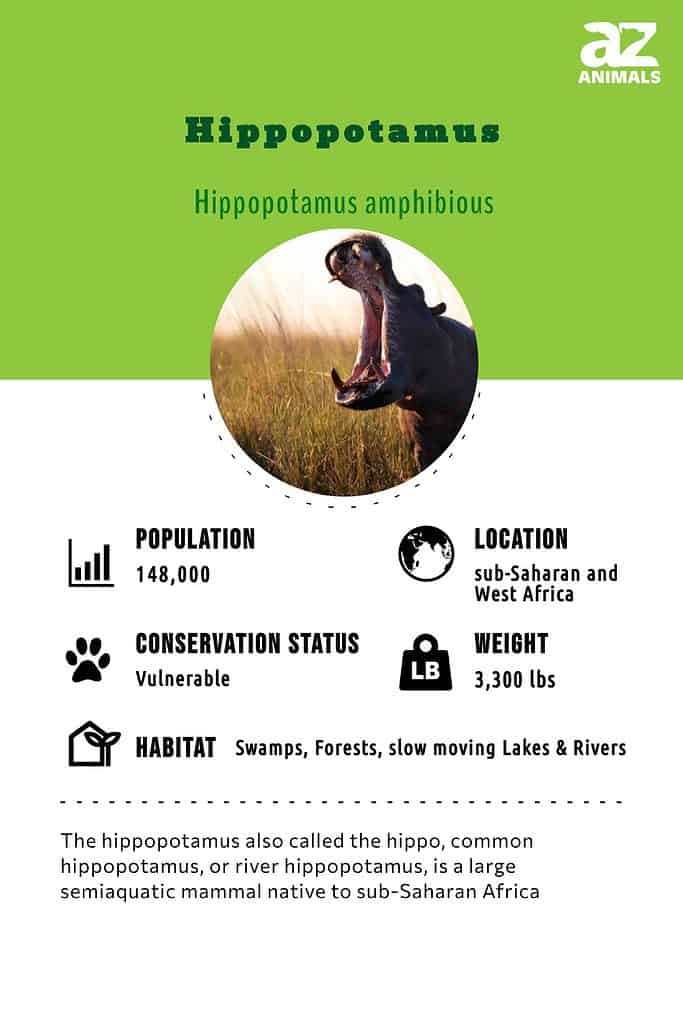
Anatomy and Appearance
The hippopotamus has an enormous grey barrel-shaped body that can measure up to 16 feet in length and weigh more than four tons, and which is held up by short and stocky legs. One of the hippopotamus’s most distinctive features is its enormous jaws which contain two long canine teeth (tusks) which can grow up to 20 inches long and are used for fighting. Due to the fact that the hippopotamus is an animal that spends most of its life resting in the water, they have a number of excellent adaptations to aid its semi-aquatic lifestyle, including four webbed toes on each foot that help with swimming and walking on slippery banks, and the eyes, ears, and nostrils of the hippopotamus are situated on the top of its head. This means that when the hippopotamus’s body is immersed in the water, they are still able to see, hear, and breathe whilst keeping cool in the hot sun.
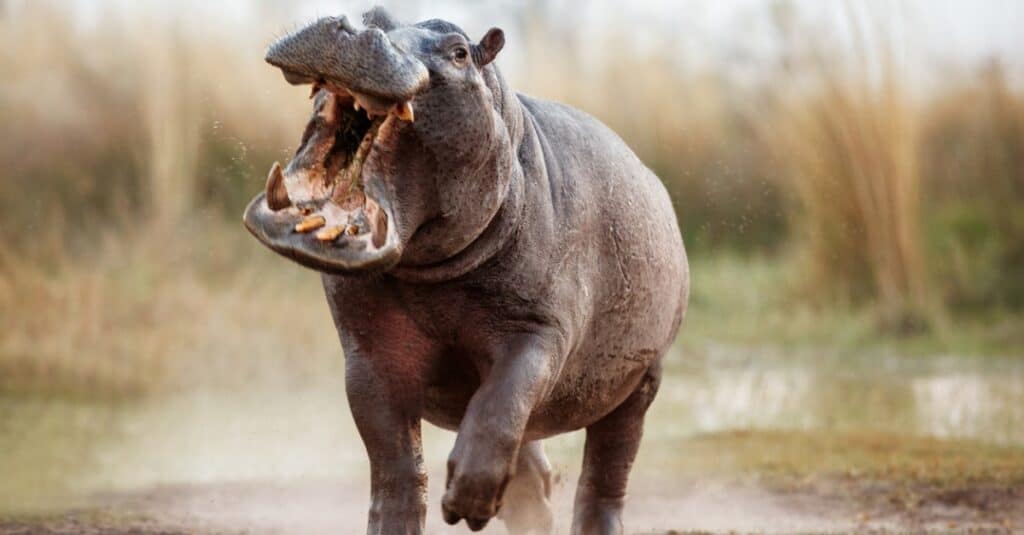
The Hippopotamus has an enormous grey barrel-shaped body that can measure up to 16 feet in length and weigh more than four tons, and which is held up by short and stocky legs.
©PhotocechCZ/Shutterstock.com
Distribution and Habitat
Although historically, the hippopotamus would have once been found across Europe and Asia, today, they are confined to Africa south of the Sahara Desert. The hippopotamus is always found close to the water and tends to prefer areas close to grasslands, where they feed during the night. Hippos are most commonly found in the deep and slow-moving rivers and lakes in eastern and southern countries, with only a few smaller and more isolated populations still found in the west. The hippopotamus is also a resident of the seasonal wetlands, where they wade through the swampy waters by day and graze on the small islands at night. Although the hippopotamus is still common throughout much of sub-Saharan Africa, their numbers have been declining, with one reason being the loss of their natural habitats, mainly caused by land clearance for agriculture.
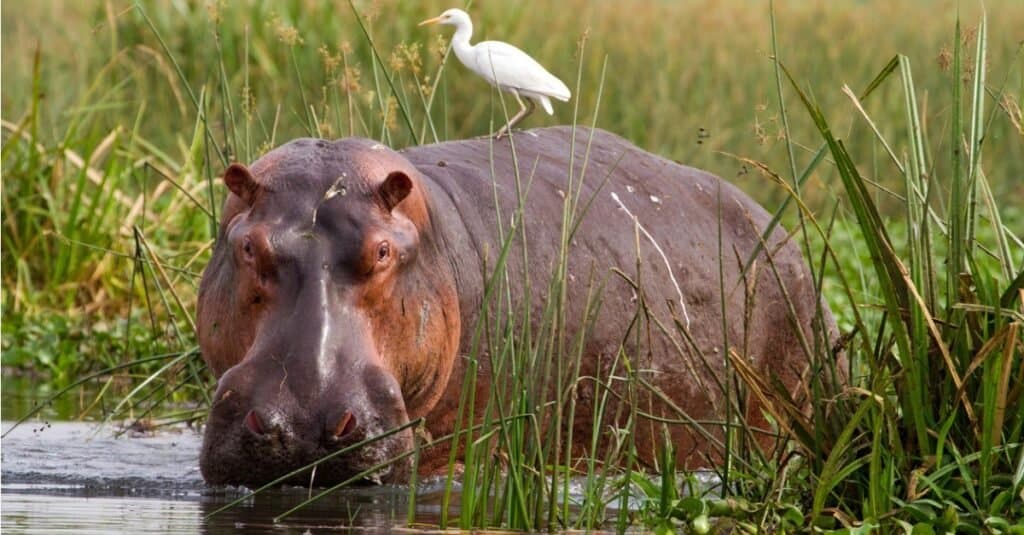
The hippopotamus (Hippopotamus amphibius) is confined to African south of the Sahara desert.
©iStock.com/PB_Images
Behaviour and Lifestyle
The hippopotamus spends up to 18 hours a day in the water to keep cool, but when darkness falls, they venture out onto land and follow well-trodden paths to their feeding grounds before returning to the water in the morning. The hippopotamus is one of the largest and most feared animals in Africa, as both males and females are known to be incredibly aggressive at points. The hippopotamus tends to live in small herds containing between 10 and 20 individuals that are comprised of females with their young. The herd is led by the dominant male, who will fiercely guard his stretch of river bank from both intruders and rival males, threatening them by opening his enormous mouth to expose the 18-inch long tusks. If this fails, the two will fight, and deadly injuries are often caused. Although the dominant male will allow other males to enter his territory, providing they are well-behaved, he holds the breeding rights with the females in the herd.
You can check out incredible hippopotamus facts.
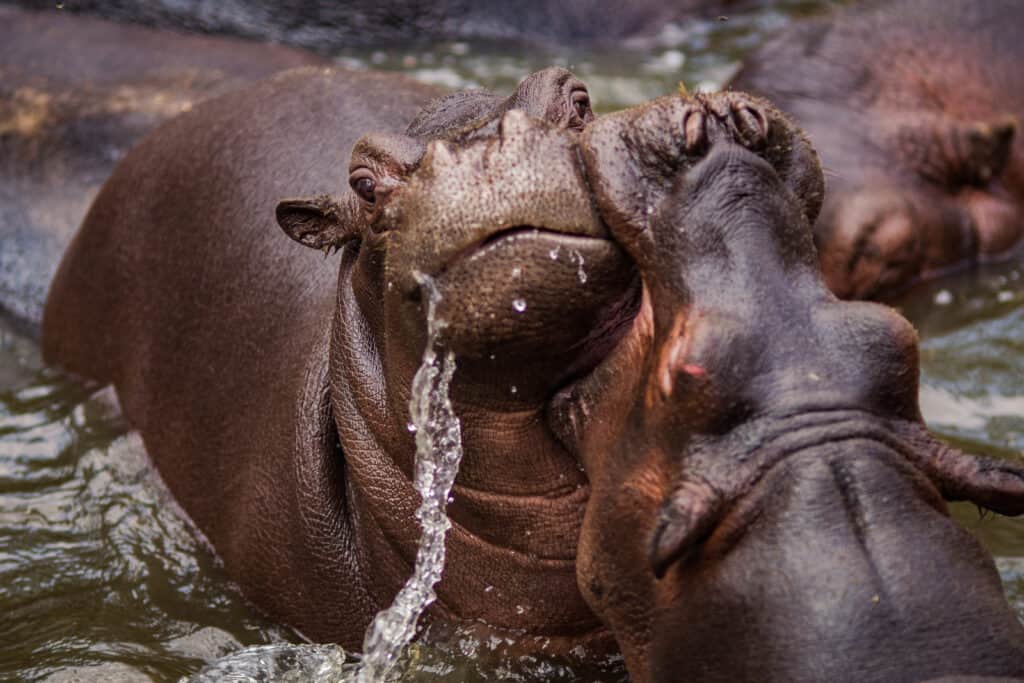
The hippo herd is led by the dominant male, who will fiercely guard his stretch of river bank from both intruders and rival males.
©jos macouzet/Shutterstock.com
Reproduction and Life Cycles
After a gestation period that lasts for around eight months, the female hippopotamus gives birth to a single calf, generally during the rainy season. Although like many other activities (including mating), the hippopotamus often gives birth in the water, it is not actually that uncommon for their young to be born on land. The female protects her calf fiercely, and it rides on her back to keep it safe. Hippopotamus calves are fully weaned by the time they are 18 months old but tend to remain with their mother until they are fully grown, often not leaving her until they are 7 or 8 years old. Although young males will become more independent and find their own patch of the bank to patrol, females will join a herd of other females and young. Despite this seemingly sociable behavior, they do not seem to interact socially and will even graze on their own when they leave the water at night.
Read more about the hippo’s lifespan here.
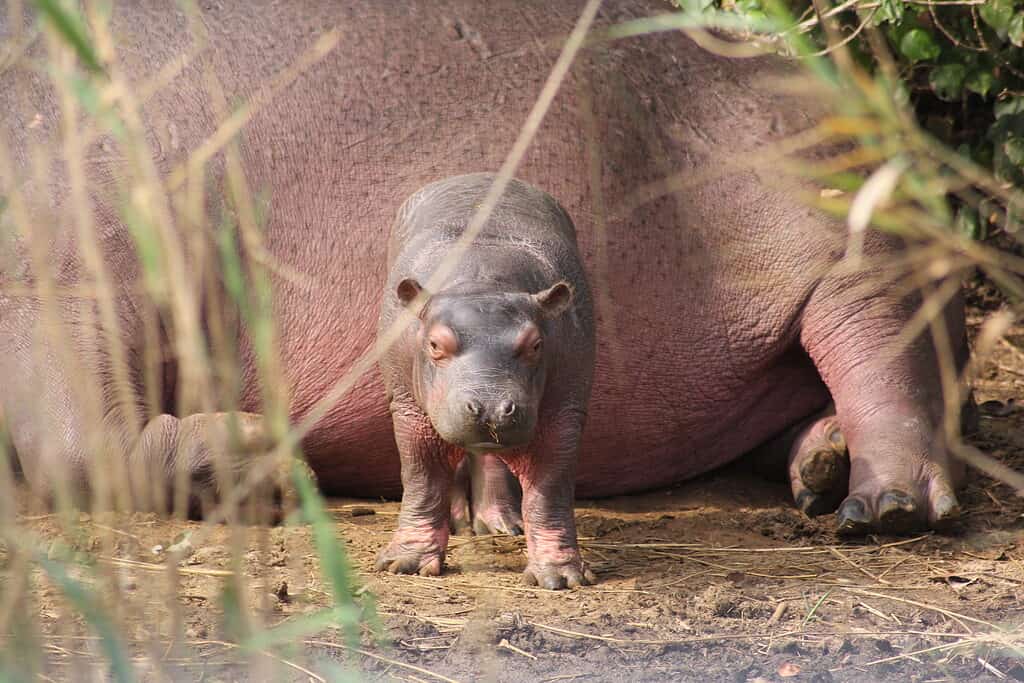
Baby hippos are fully weaned by 18 months old.
©Kelly Engelbrecht/Shutterstock.com
Diet and Prey
The hippopotamus is a herbivorous animal, meaning that despite its enormously long and sharp teeth, they are vegetarians. Different species of grasses are the main source of food for the hippopotamus that is found growing on plains relatively close to water. When they come onto land at night, hippos may travel up to three miles during the night to get to their feeding grounds which they do by following paths that are marked with dung. Oddly enough, the hippopotamus doesn’t even use its large canines for eating at all but instead has strong lips that are used to clip the grasses and cheek teeth which then grind them up. Despite its large size, the hippopotamus only eats around 88 pounds of food a night as it uses very little energy whilst floating in the water for most of the day. In areas that are close to human settlements, hippos have also been known to invade crops consuming mainly rice plants and simply trampling over others. For a complete list of the food a hippopotamus eats, have a look at our “What Do Hippos Eat?” page!
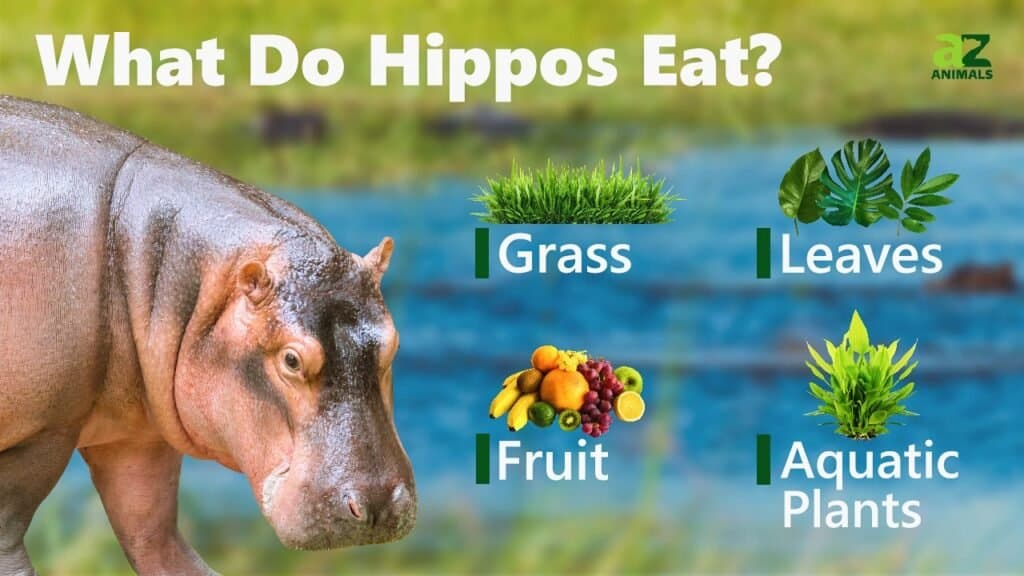
Predators and Threats
The hippopotamus is one of the largest mammals on the African continent. Although mature adults are much harder for predators to kill, they are still preyed on by a number of predators throughout the wetlands. Big cats such as lions and other animals like hyenas and crocodiles are the most common predators of the hippopotamus, particularly of young or sick individuals. It is because of this that females are thought to congregate in herds, as larger numbers are more intimidating to hungry carnivores. The hippopotamus is also threatened by people, not only from the loss of their natural habitats but also from hunting. The hippopotamus has been hunted by people for both its meat and its teeth which are made of ivory. Since the ban on trading elephant ivory, the number of hippos killed for their teeth has risen dramatically.

Big cats such as lions and other animals like hyenas and crocodiles are the most common predators of the hippopotamus.
©Arnold Mugasha/Shutterstock.com
Interesting Facts and Features
The hippopotamus has an enormous head that makes up around a third of its total body weight, with its vast mouth being able to open up to 150 degrees and revealing its large tusks, which can weigh up to 6 pounds each. Due to the way that the skin of the hippopotamus is made up, the animal cannot sweat, so when it comes into contact with air, the skin easily dries up. Although this is not a problem in the water, to combat this the rest of the time, a pink, oily substance is secreted through glands in the skin, which is not only thought to prevent sunburn but also may have anti-bacterial properties that help to keep wounds clean and prevent infection from the dirty water. Even though the hippopotamus looks like it would be slow on land thanks to its short and stubby legs, they are actually able to run at quite remarkable speeds and are capable of reaching 30 miles per hour when running.

Hippos can open their mouths 150 degrees, and their tusks can weigh up to 6 pounds each.
©Karel Bartik/Shutterstock.com
Relationship with Humans
The hippopotamus can be found in all kinds of ancient African folklore, with its name in Greek actually meaning “Water Horse.” Despite this fascination with the hippopotamus, hunting them for their meat and tusks has wiped them out from vast areas of their once large natural range, and numbers continue to fall, particularly in certain areas due to habitat loss. In these areas where the hippopotamus is often forced to raid crops in order to find food, they are seen as pests by farmers who do not only fear for their livelihood but also for their lives themselves. The hippopotamus is known to be an aggressive animal that is considered by many to be among Africa’s most dangerous mammals, as attacks on people (particularly fishermen) are not unheard of.
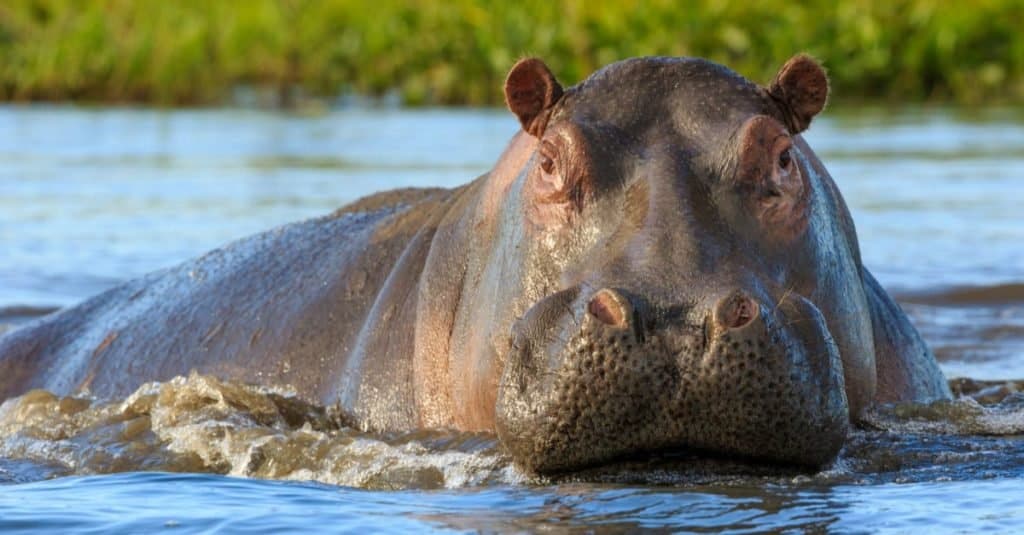
A Hippopotamus is known to be an aggressive animal.
©Radek Borovka/Shutterstock.com
Conservation Status and Life Today
Today, the hippopotamus is listed by the IUCN as an animal that is Vulnerable in its natural environment. Over the past 10 years, their populations have declined by 7-20%. However, the hippopotamus is still considered to be abundant throughout much of its current natural range, with the exception of populations in western Africa that are becoming more and more isolated. Although hippopotamus populations are considered stable in a number of countries in the south and the east of the continent, they are declining in many others. They are particularly threatened by continuing poaching of them for their tusks.

Currently, hippos are confined mostly to protected areas, and over the past 10 years, their populations have declined by 7-20%
©Sergey Uryadnikov/Shutterstock.com
2 Types of Hippopotamus
There are two hippo species, both found in Africa. The common hippopotamus (also called the large hippopotamus) and the pygmy hippopotamus.
Large/Common Hippopotamus: The common hippopotamus (Hippopotamus amphibious) is native to sub-Saharan Africa and is one of the largest land mammals. An adult hippo can weigh 3,300 pounds and stand 5.5 feet tall at the shoulder.
Pygmy hippopotamus: The pygmy hippo (Choeropsis liberiensis) is a much smaller species of hippo, about half as tall as the common hippo. Adults stand a little over three feet tall and are 400-600 pounds. They are limited to protected areas in West Africa that are forested. Shy and reclusive, this hippopotamus is mostly nocturnal.

Pygmy Hippos are half the height and weight of common hippos.
©Millie Bond – Copyright A-Z Animals
More on Hippopotamus
View all 104 animals that start with HHippopotamus FAQs (Frequently Asked Questions)
What are the differences between a rhino and hippo?
The most obvious difference that separates hippos vs. rhinos is the fact that rhinos have horns on their heads while hippos have sharp teeth in their mouth. The two animals are a similar size and can even run at similar speeds.
Are Hippopotamuses herbivores, carnivores, or omnivores?
Hippopotamuses are Herbivores, meaning they eat plants.
What Kingdom do Hippopotamuses belong to?
Hippopotamuses belong to the Kingdom Animalia.
What class do Hippopotamuses belong to?
Hippopotamuses belong to the class Mammalia.
What phylum to Hippopotamuses belong to?
Hippopotamuses belong to the phylum Chordata.
What family do Hippopotamuses belong to?
Hippopotamuses belong to the family Hippopotamidae.
What order do Hippopotamuses belong to?
Hippopotamuses belong to the order Artiodactyla.
What type of covering do Hippopotamuses have?
Hippopotamuses are covered in Leathery skin.
What genus do Hippopotamuses belong to?
Hippopotamuses belong to the genus Hippopotamus.
Where do Hippopotamuses live?
Hippopotamuses live in sub-Saharan Africa.
In what type of habitat do Hippopotamuses live?
Hippopotamuses live in lakes, rivers, and wetlands.
What are some predators of Hippopotamuses?
Predators of Hippopotamuses include lions, hyenas, and crocodiles.
How many babies do Hippopotamuses have?
The average number of babies a Hippopotamus has is 1.
What is an interesting fact about Hippopotamuses?
Hippopotamuses have pink anti-bacterial sweat!
What is the scientific name for the Hippopotamus?
The scientific name for the Hippopotamus is Hippopotamus amphibius.
What is the lifespan of a Hippopotamus?
Hippopotamuses can live for 40 to 50 years.
What is a baby Hippopotamus called?
A baby Hippopotamus is called a calf.
How many species of Hippopotamus are there?
There is 1 species of Hippopotamus.
What is the biggest threat to the Hippopotamus?
The biggest threats to the Hippopotamus are hunting and habitat loss.
What is another name for the Hippopotamus?
The Hippopotamus is also called the common hippopotamus or water horse.
How many Hippopotamuses are left in the world?
There are 150,000 Hippopotamuses left in the world.
How fast is a Hippopotamus?
A Hippopotamus can travel at speeds of up to 30 miles per hour.
Who would win a fight between a polar bear and a hippo?
A hippo would win a fight against a polar bear. The hippo is larger, stronger, has better offensive powers and a defense that would allow it to last longer in a battle than a polar bear.
Sure, the polar bear could use its claws to cut the hippo to ribbons, but it would take some time and power to cut through all that flesh and fat. There’s no way that the hippo, one of the most powerful, aggressive animals in the world, sits there and takes that damage. Instead, the hippo needs one or two bites to incapacitate the polar bear.
Who would win a fight between a hippo and an alligator?
A hippo would win a fight against an alligator.
Simply put, alligators don’t have the toolkit to bring down and kill something as large as a hippo. Even if the average alligator ambushed a hippo and tried to perform a death roll, it’s not going to get much for its effort. The hippo is too thickly built and heavy.
How to say Hippopotamus in ...
Thank you for reading! Have some feedback for us? Contact the AZ Animals editorial team.
Sources
- David Burnie, Dorling Kindersley (2011) Animal, The Definitive Visual Guide To The World's Wildlife
- Tom Jackson, Lorenz Books (2007) The World Encyclopedia Of Animals
- David Burnie, Kingfisher (2011) The Kingfisher Animal Encyclopedia
- Richard Mackay, University of California Press (2009) The Atlas Of Endangered Species
- David Burnie, Dorling Kindersley (2008) Illustrated Encyclopedia Of Animals
- Dorling Kindersley (2006) Dorling Kindersley Encyclopedia Of Animals
- David W. Macdonald, Oxford University Press (2010) The Encyclopedia Of Mammals
- Hippopotamus Information, Available here: http://www.iucnredlist.org/apps/redlist/details/10103/0

















